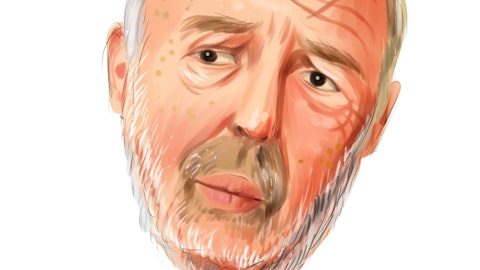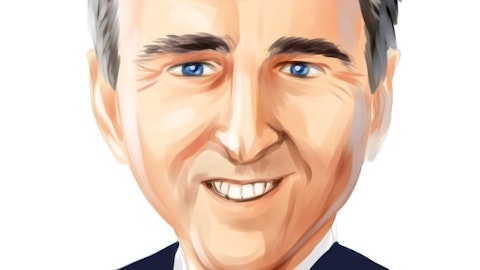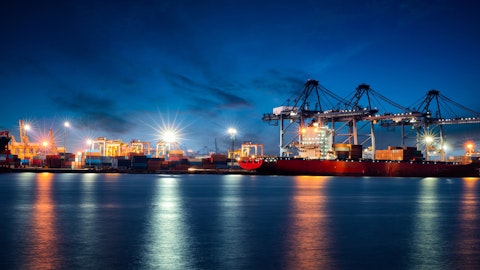KNOT Offshore Partners LP (NYSE:KNOP) Q4 2022 Earnings Call Transcript March 15, 2023
Operator: Hello and welcome to the KNOT Fourth Quarter 2022 Earnings Results Conference Call. My name is Bailey, and I’ll be your moderator for today’s call. I would now like to pass the conference over to Gary Chapman, CEO and CFO. Gary, please go ahead.
Gary Chapman: Thank you and welcome everybody to our fourth quarter 2022 earnings call. The earnings release and this presentation are available on our website at knotoffshorepartners.com if you want to view them. Slide 2 gives guidance on the inclusion of forward-looking statements in today’s presentation, which are made in good faith, but which contain risks and uncertainties, meaning that actual results may be materially different. The Partnership does not have or undertake a duty to update any such forward-looking statements. And for further information, please consult our annual and quarterly SEC filings. Today’s presentation also includes certain non-U.S. GAAP measures and our earnings release includes a reconciliation of these to the most directly comparable GAAP measures.
On to slides 3 and 4 are highlights from the fourth quarter of 2022 and subsequent. We announced a cash distribution of $0.026 per common unit under a 1099 structure, which although reduced was the 29th consecutive distribution overall since the Partnership first listed in 2013. Our fleet in the fourth quarter operated with 96.1% for scheduled operations and 94.9% utilization taking into account scheduled drydocking as of the Carmen Knutsen. Since we last reported we’ve been busy. On November 29, 2022, Repsol Sinopec, the charterer of the Carmen Knutsen, confirmed its option to extend the existing time charter of the vessel by one further year. The vessel is now fixed until January 2024, with Repsol Sinopec holding options to extend the time charter by two further one-year periods.
And since the end of the fourth quarter, we’ve signed six new contracts or extensions, including a new 10-month contract with Altera for the Ingrid Knutsen contract extension, so the Tordis Knutsen and the Lena Knutsen and new contracts with our sponsor Knutsen NYK for the Bodil Knutsen, Hilda Knutsen and the Torill Knutsen. The three contracts with our sponsor were approved by the Partnership’s Independent Conflicts Committee and provide a level of certainty to the Partnership. And in respect of the Bodil Knutsen and the Ingrid Knutsen, these vessels are now contracted to at least fourth quarter of 2025 and 2026, respectively. In addition, during the fourth quarter or since three of our vessels, the Windsor Knutsen, the Torill Knutsen and the Ingrid Knutsen, have operated for at least some time in the spot market, either performing conventional tanker voyages or offshore loading voyages, and each has been able to generate a positive contribution from those activities.
The Windsor Knutsen was also successfully delivered to Shell on January 11, 2023, commencing on a fixed one year charter, which Shell also have an option to extend the charter by one further year. And then finally, we have agreed commercial terms for a new multiyear time charter contract for each of the Fortaleza Knutsen and Recife Knutsen with Transpetro, to commence directly upon expiration of the existing bareboat charters. We are now awaiting charters management approval, which we anticipate will follow shortly. The increased market activity in our main market, Brazil, continued in the fourth quarter and to date, we expect this will persist based on current market parameters and conditions. The North Sea time charter market where currently 4 of our 18 vessels operate remained subdued, taking longer to return to the predicted higher levels of oil production and shuttle tanker demand.
However, we have secured a level of income for all of these 4 vessels in 2023 with the Bodil Knutsen and the Ingrid Knutsen secured until the fourth quarter 2025 and 2026, respectively, as I mentioned. At December 31, 2022, the Partnership had $47.6 million in available liquidity, and the fleet had an average age of 8.7 years, with each vessel having an estimated useful life of 23 years. Slides 5 through 7 are summary of financial results. And as usual, I will just mention a few points. On slide 5, our revenues were strong in the fourth quarter and indeed there may be over $1 million more in loss of hire insurance to come, resulting from insurance claims for the Windsor Knutsen and the Synnøve Knutsen that under U.S. GAAP, we’re not allowed to recognize in the accounts as we’re not yet sure of the final amount.
Operating expenses were lower in the fourth quarter, largely reflecting higher bunker fuel costs in connection with multiple vessel dry docks in both the second and third quarters. Recalling that when time charter vessels are on hire, fuel is a cost for our customers, but these vessels are off-hire during their drydock. Crew, crew related costs and logistics remained somewhat elevated compared to historic averages ever since the COVID-19 pandemic and which level we believe is probably now the new normal as we move forward. As we have mentioned before, with a wide and geographically spread crew and supply base to draw upon, we believe we have some protection against the inflationary pressures that are occurring in many countries just now. However, this is something that we, like all companies, are keeping under close review.
Higher LIBOR, higher utilization of our revolving facilities and having an 18 vessel from July 1, 2022 have all increased interest expenses during 2022, and this trend continued in the fourth quarter. However, this has not had any impact on our continuing and scheduled debt repayments made during the year. At December 31, 2022, the Partnership’s net exposure to floating interest rate fluctuations was $372.5 million or 35% of our total interest bearing debt. In other words, 65% was fixed by interest rate swaps or effectively fixed by our two sale and leaseback financings. On slide 6, you can see our cash and cash equivalents balance at the end of the quarter of $47.6 million. And we are working on the upcoming debt refinancings, the first of which falls due in August 2023.
And to date, we have no reason to believe that they will not be refinanced on acceptable and similar terms and in good time prior to maturity. At present, we are not targeting to borrow more, that is we do not currently plan to increase our leverage on any of the facilities. On slide 7, you can see the overall adjusted EBITDA result for the fourth quarter was very solid, and indeed it was the highest achieved in 2022. Slide 8 is an update on our contracted revenue and charter portfolio. As before, we have covered many of the contractual updates already, and they are also set out in the earnings release. So, I won’t repeat them here, other than to say that we are pleased with the progress we have been able to make in the fourth quarter of 2022 and subsequent.
We are in a position where we have contract coverage for almost the whole of 2023 and several vessels are now under contract for much longer periods. It’s still a work-in-progress, but we have certainly made progress. Including contracts and extensions signed since December 31, 2022, we have remaining forward contracted revenue of $715 million. This figure excludes options but it does include contracts and extensions signed since December 31, 2022. And as we have agreed commercial terms, though we have not yet signed, we have included the anticipated charters on a bareboat basis for the Fortaleza Knutsen and Recife Knutsen. Of our term charters, these have 2.1 years remaining on average and charterers had options to extend these charters by further 2.2 years on average.
On slide 9, we are showing our contract coverage in a different way. This slide is not saying that utilization in the first quarter of 2023 will be 100%, but rather that for this quarter, there are not further outstanding days still to be covered by a charter contract. This slide perhaps most clearly demonstrates where our work and focus is needed to restore forward visibility of earnings, to which we have very frequently referred to in the past. Then on slide 10, we have the potential dropdown vessels held by our sponsor KNOP that the Partnership may choose to purchase in the future. It remains the Partnership’s target to acquire these vessels from the sponsor when suitable opportunities arrive. However, there is of course no guarantee that this will actually be possible.
Slide 11, we have included a similar slide in previous presentations, but we believe this remains a very valuable source of independent information that speaks to the future of shuttle tanker demand in Brazil. Indeed, the number of new FPSOs to be deployed in Brazil through to 2027 equates to approximately 50% of the world’s total FPSOs. And with a low carbon score and low marginal cost of oil production, we remain very positive with respect to the mid- to long-term outlook here. We have also included a further slide in the appendix to this presentation to give some more detail. On slide 12, as we have highlighted previously, despite the forecast growth in demand for shuttle tankers in the mid- and long-term, only a very small number of new shuttle tanker orders have been placed for deliveries in 2023, 2024 and 2025, constituting approximately 8% of current shuttle tankers in service.
Given this and with the main shipyards having very limited or no capacity due to containership and LNG carrier orders through 2025, the total order book for shuttle tankers is likely to remain very muted. Hence, we continue to expect that the market will meaningfully tighten, potentially to the point of shortage. There does remain some uncertainty around forecasting the specific timing of such market developments. Newbuild shuttle tanker prices indeed the prices of any new ship today remain elevated, up over 30% in the second half of 2021, as a result of tight shipyard capacity and higher input prices for steel and labor, all of which continues to help the competitiveness of our existing fleet. So, in summary for this quarter on slide 13, we had good utilization of 96.1% for scheduled operations.
We paid a quarterly distribution for the 39th consecutive quarters, albeit at a reduced level. And we have commenced discussions with lenders for our upcoming refinancings. And since December 31, 2022, we assigned six new charters and extensions, and agreed commercial terms for multiyear charters for two further vessels. Overall, we’ve made good progress and important progress towards restoring visibility of earnings and a sustainable path forward. And of course, there remains more to do. In the near-term, as always, our focus is on safe operations, both onboard and onshore and to take care of our crew whilst maintaining our high standards and utilization statistics. Our other main focus is on the refinancings due in 2023. And we are well underway with these processes and hope to be in a position to have each closed well in advance of each maturity date.
After the Carmen Knutsen drydock which is already completed, there remains four further scheduled drydock in 2023 to take place in Europe in which we are planning for. Three of these vessels are European based, so mobilization costs will be lower than for the Brazilian based vessels. And hopefully, it goes without saying that we are talking to our customers and proactively monitoring the market to ensure we can respond flexibly as charter or even spot opportunities arise. And on slide 14, we have just put this in here to promote our newly refreshed website. We’ve tried to add a little more background content on shuttle tankers, and we will try to continue to do so over time. And hopefully people will find it useful and provide an improved experience.
Thank you for listening and following this more formal part of the call. I’ll be very happy to answer any questions.
See also US States’ GDP Compared to Other Countries and 25 Highest Paid Athletes of All Time.
Q&A Session
Follow Knot Offshore Partners Lp (NYSE:KNOP)
Follow Knot Offshore Partners Lp (NYSE:KNOP)
Receive real-time insider trading and news alerts
Operator: Thank you. The first question today comes from the line of Liam Burke from B. Riley. Please go ahead. Your line is now open.
Liam Burke: Gary, a lot of your discussion on the market is Brazil. You have four vessels in the North Sea. If I look at the newbuilding schedule, that’s all slated for Brazil. Could you either give us color on the North Sea market, or does it make more sense to move capacity to Brazil?
Gary Chapman: Yes. The North Sea market, as we said, is a little bit soft and it’s still the overhang from the project delays that we’ve seen historically. In terms of moving vessels down to Brazil, we certainly haven’t ruled that out. The timing is everything. And we would obviously also incur not insignificant costs in moving the vessels down to Brazil. So, we would want to be really sure that if we did that it would be a successful move. And so, I come back to my first point that timing is everything there to do that. But it’s certainly something we haven’t ruled out.
Liam Burke: Okay. Obviously your contracting outlook looks a lot better with what you’ve done in the fourth quarter. Does that help in you negotiations for your debt refinancings?
Gary Chapman: Yes, absolutely, absolutely. We think we will be able to successfully close all of those anyway, regardless. But of course, all of our institutional lenders clearly are interested in us being a successful business. But yes, of course, it helps. But nonetheless, we were confident that we would be able to get all of these refinancings done on a timely basis regardless, but yes, of course, it helps.
Liam Burke: And that also includes the two revolvers that are up for renewal in — later in the year?
Gary Chapman: That’s correct. It includes those. Yes.
Operator: Our next question today comes from the line of Richard Diamond from Castlewood. Please go ahead. Your line is now open.
Richard Diamond: Gary, good morning. I want to commend you on the progress you’ve made since the beginning of the year. And I have a quick market question. Are charterers aware that today you have significant potential market. If
Gary Chapman: Sorry. Richard, I’m — very quiet.
Richard Diamond: Okay. Can you hear me?
Gary Chapman: That’s much better. Thank you. If you wouldn’t mind starting again.
Richard Diamond: Okay. One, I want to commend you on making a lot of progress. It’s not easy and hats off. Secondly, are charterers aware that you have or we have significant choices in the marketplace? If you were a conventional tanker company, you could charter out your vessels and your stock price would likely double. I understand our strategy and I buy into it. I’m just wondering if the charterers understand how vulnerable they are, if shuttle tankers leave for conventional shipping.
Gary Chapman: Yes. Richard, it’s a great point and a great question. And yes, absolutely, we’re very much aware of that. And we make sure our customers are aware of that, if they’re not already aware of it by their own analysis. I mean, certainly, our shuttle tankers are irreplaceable. So — and there are only so many of them and with the yards full up, supply isn’t going to suddenly increase in the next few years. So, I think it’s something that we’re — we continually press with our customers that perhaps they do need to take a close look at what’s going to be available when they need it. So — and I think we’ve seen a little bit of that with Equinor fixing some of the vessels, Windsor and Bodil for example in the North Sea, so Bodil. So I think there is a little bit of movement there. And I think we’re increasingly seeing that certainly in Brazil, for sure, for sure.






